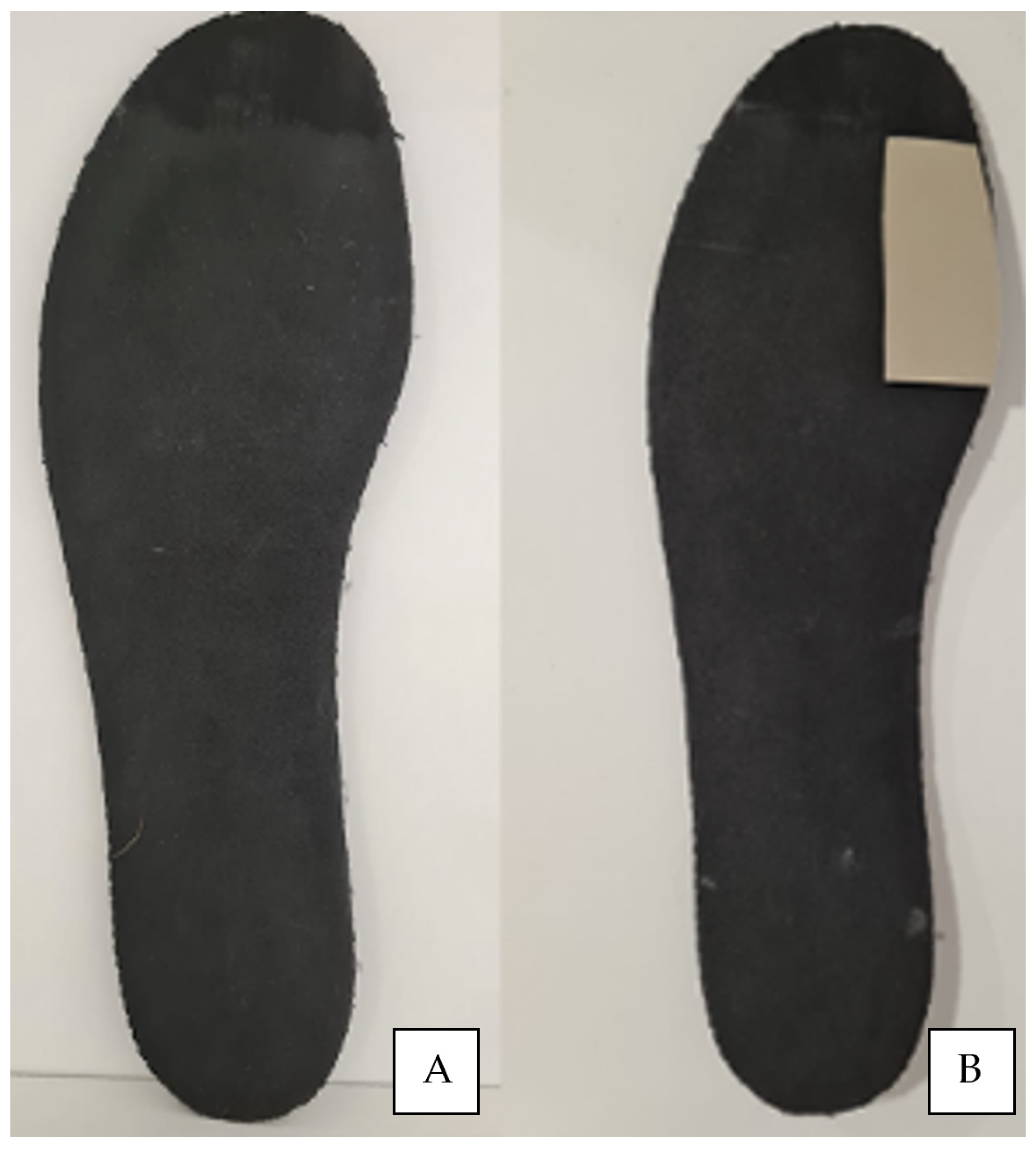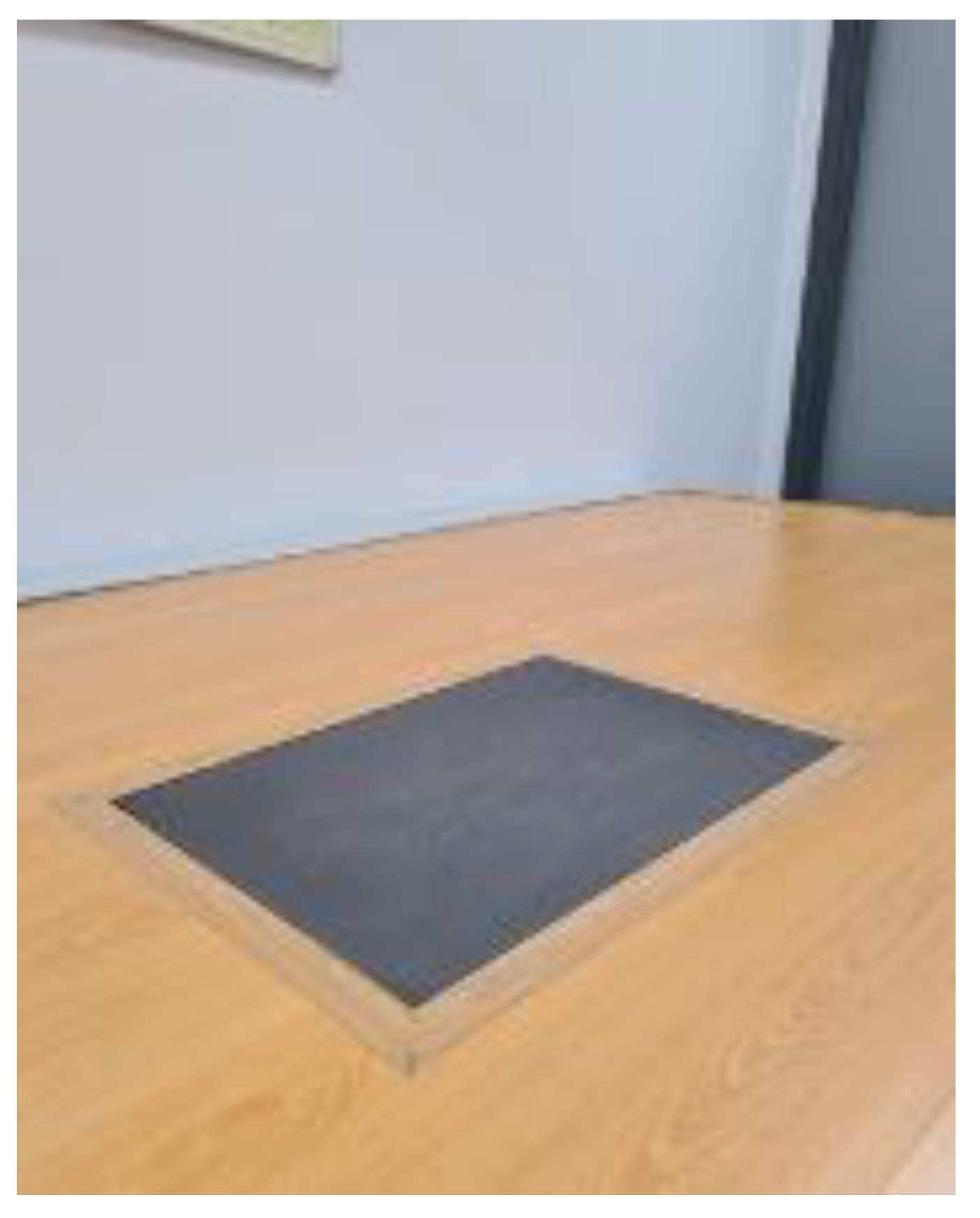Pilot Study: Effect of Morton’s Extension on the Subtalar Joint Forces in Subjects with Excessive Foot Pronation
Abstract
1. Introduction
2. Materials and Methods
2.1. Trial Design
2.2. Inclusion/Exclusion Criteria
2.2.1. Inclusion Criteria
2.2.2. Exclusion Criteria
2.2.3. Procedure
2.2.4. Ethical Statements
3. Results
3.1. Description of the Total Sample
3.1.1. Descriptive Data
3.1.2. Interferential Data
4. Discussion
5. Conclusions
Author Contributions
Funding
Institutional Review Board Statement
Informed Consent Statement
Data Availability Statement
Conflicts of Interest
References
- Braga, U.M.; Mendonça, L.D.; Mascarenhas, R.O.; Alves, C.O.A.; Filho, R.G.T.; Resende, R.A. Effects of Medially Wedged Insoles on the Biomechanics of the Lower Limbs of Runners with Excessive Foot Pronation and Foot Varus Alignment. Gait Posture 2019, 74, 242–249. [Google Scholar] [CrossRef] [PubMed]
- Gijon-Nogueron, G.; Ndosi, M.; Luque-Suarez, A.; Alcacer-Pitarch, B.; Munuera, P.V.; Garrow, A.; Redmond, A.C. Cross-Cultural Adaptation and Validation of the Manchester Foot Pain and Disability Index into Spanish. Qual. Life Res. 2014, 23, 571–579. [Google Scholar] [CrossRef] [PubMed]
- Gordillo-Fernández, L.M.; Ortiz-Romero, M.; Valero-Salas, J.; Salcini-Macías, J.L.; Benhamu-Benhamu, S.; García-De-La-Peña, R.; Cervera-Marin, J.A. Effect by Custom-Made Foot Orthoses with Added Support under the First Metatarso-Phalangeal Joint in Hallux Limitus Patients: Improving on First Metatarso-Phalangeal Joint Extension. Prosthet. Orthot. Int. 2015, 40, 668–674. [Google Scholar] [CrossRef] [PubMed]
- Baur, H.; Hirschmüller, A.; Müller, S.; Mayer, F. Neuromuscular Activity of the Peroneal Muscle after Foot Orthoses Therapy in Runners. Med. Sci. Sports Exerc. 2011, 43, 1500–1506. [Google Scholar] [CrossRef] [PubMed]
- Sánchez-Gómez, R.; Romero-Morales, C.; Gómez-Carrión, Á.; De-La-cruz-torres, B.; Zaragoza-García, I.; Anttila, P.; Kantola, M.; Ortuño-Soriano, I. Effects of Novel Inverted Rocker Orthoses for First Metatarsophalangeal Joint on Gastrocnemius Muscle Electromyographic Activity during Running: A Cross-Sectional Pilot Study. Sensors 2020, 20, 3205. [Google Scholar] [CrossRef]
- Sha, Z.; Dai, B. The Validity of Using One Force Platform to Quantify Whole-Body Forces, Velocities, and Power during a Plyometric Push-Up. BMC Sports Sci. Med. Rehabil. 2021, 13. [Google Scholar] [CrossRef]
- Redmond, A.C.; Crosbie, J.; Ouvrier, R.A. Development and Validation of a Novel Rating System for Scoring Standing Foot Posture: The Foot Posture Index. Clin. Biomech. 2006, 21, 89–98. [Google Scholar] [CrossRef]
- Zhang, X.; Pauel, R.; Deschamps, K.; Jonkers, I.; Vanwanseele, B. Differences in Foot Muscle Morphology and Foot Kinematics between Symptomatic and Asymptomatic Pronated Feet. Scand. J. Med. Sci. Sports 2019, 29, 1766–1773. [Google Scholar] [CrossRef]
- Kerr, C.M.; Zavatsky, A.B.; Theologis, T.; Stebbins, J. Kinematic Differences between Neutral and Flat Feet with and without Symptoms as Measured by the Oxford Foot Model. Gait Posture 2019, 67, 213–218. [Google Scholar] [CrossRef]
- Wong, L.; Hunt, A.; Burns, J.; Crosbie, J. Effect of Foot Morphology on Center-of-Pressure Excursion during Barefoot Walking. J. Am. Podiatr. Med. Assoc. 2008, 98, 112–117. [Google Scholar] [CrossRef]
- Hillstrom, H.J.; Song, J.; Kraszewski, A.P.; Hafer, J.F.; Mootanah, R.; Dufour, A.B.; Chow, B.S.; Deland, J.T. Foot Type Biomechanics Part 1: Structure and Function of the Asymptomatic Foot. Gait Posture 2013, 37, 445–451. [Google Scholar] [CrossRef] [PubMed]
- Buldt, A.K.; Forghany, S.; Landorf, K.B.; Murley, G.S.; Levinger, P.; Menz, H.B. Centre of Pressure Characteristics in Normal, Planus and Cavus Feet. J. Foot Ankle Res. 2018, 11. [Google Scholar] [CrossRef] [PubMed]
- Grady, J.F.; Axe, T.M.; Zager, E.J.; Sheldon, L.A. A Retrospective Analysis of 772 Patients with Hallux Limitus. J. Am. Podiatr. Med. Assoc. 2002, 92, 102–108. [Google Scholar] [CrossRef] [PubMed]
- Nyska, M.; Mccabe, C.; Linge, K.; Laing, P.; Klenerman, L. Effect of the Shoe on Plantar Foot Pressures. Acta Orthop. Scand. 1995, 66, 53–56. [Google Scholar] [CrossRef]
- Van Gheluwe, B.; Dananberg, H.J. Changes in Plantar Foot Pressure with In-Shoe Varus or Valgus Wedging. J. Am. Podiatr. Med. Assoc. 2004, 94, 1–11. [Google Scholar] [CrossRef]
- Johanson, M.A.; Donatelli, R.; Wooden, M.J.; Andrew, P.D.; Cummings, G.S.; Mueller, M.J. Effects of Three Different Posting Methods on Controlling Abnormal Subtalar Pronation. Phys. Ther. 1994, 74, 149–161. [Google Scholar] [CrossRef]
- Costa, B.L.; Magalhães, F.A.; Araújo, V.L.; Richards, J.; Vieira, F.M.; Souza, T.R.; Trede, R. Is There a Dose-Response of Medial Wedge Insoles on Lower Limb Biomechanics in People with Pronated Feet during Walking and Running? Gait Posture 2021, 90, 190–196. [Google Scholar] [CrossRef]
- Bonifácio, D.; Richards, J.; Selfe, J.; Curran, S.; Trede, R. Influence and Benefits of Foot Orthoses on Kinematics, Kinetics and Muscle Activation during Step Descent Task. Gait Posture 2018, 65, 106–111. [Google Scholar] [CrossRef]
- McMillan, A.; Payne, C. Effect of Foot Orthoses on Lower Extremity Kinetics during Running: A Systematic Literature Review. J. Foot Ankle Res. 2008, 1, 1–8. [Google Scholar] [CrossRef]
- Mündermann, A.; Nigg, B.M.; Humble, R.N.; Stefanyshyn, D.J. Foot Orthotics Affect Lower Extremity Kinematics and Kinetics during Running. Clin. Biomech. 2003, 18, 254–262. [Google Scholar] [CrossRef]
- Morley, J.B.; Decker, L.M.; Dierks, T.; Blanke, D.; French, J.A.; Stergiou, N. Effects of Varying Amounts of Pronation on the Mediolateral Ground Reaction Forces during Barefoot versus Shod Running. J. Appl. Biomech. 2010, 26, 205–214. [Google Scholar] [CrossRef]
- Zhao, X.; Wang, M.; Fekete, G.; Baker, J.S.; Wiltshire, H.; Gu, Y. Analyzing the Effect of an Arch Support Functional Insole on Walking and Jogging in Young, Healthy Females. Technol. Health Care 2021, 29, 1141–1151. [Google Scholar] [CrossRef] [PubMed]
- Lourenço, B.M.; Magalhães, F.A.; Vieira, F.M.; Reis, C.K.; Costa, H.S.; Araújo, V.L.; Richards, J.; Trede, R. An Exploration of the Effects of Prefabricated and Customized Insoles on Lower Limb Kinetics and Kinematics during Walking, Stepping up and down Tasks: A Time Series Analysis. Gait Posture 2022, 98, 297–304. [Google Scholar] [CrossRef] [PubMed]
- Zhang, X.; Lam, W.K.; Vanwanseele, B. Dose-Response Effects of Forefoot and Arch Orthotic Components on the Center of Pressure Trajectory during Running in Pronated Feet. Gait Posture 2022, 92, 212–217. [Google Scholar] [CrossRef] [PubMed]


| Total Sample n = 15 | Minimum | Maximum | X(D.S) |
|---|---|---|---|
| Max. pronation barefoot | 48.9 | 92.3 | 71.2 (13.9) |
| Max. pronation flat insole | 28.7 | 82 | 63.5 (13.8) |
| Max. pronation Morton’s extension | 42.4 | 79.3 | 64.1 (11.7) |
| Max. supination barefoot | −124.9 | −5.4 | −58.3 (39.2) |
| Max. supination flat insole | −79.4 | −9.5 | −36.9 (29.9) |
| Max. supination Morton’s extension | −55 | −15 | −37.8 (14.2) |
| Total Sample n = 15 | Minimum | Maximum | X(D.S) |
|---|---|---|---|
| Max. Pronation barefoot | 14 | 80 | 43.6 (25.61) |
| Max. Pronation flat insole | 6 | 80 | 43.73 (28.8) |
| Max. Pronation Morton’s | 14 | 78 | 45.47 (26.98) |
| Max. Supination barefoot | 4 | 4 | --- |
| Max Supination flat insole | 4 | 18 | 6.67 (3.34) |
| Max Supination Morton’s | 4 | 8 | 5.33 (1.48) |
Disclaimer/Publisher’s Note: The statements, opinions and data contained in all publications are solely those of the individual author(s) and contributor(s) and not of MDPI and/or the editor(s). MDPI and/or the editor(s) disclaim responsibility for any injury to people or property resulting from any ideas, methods, instructions or products referred to in the content. |
© 2023 by the authors. Licensee MDPI, Basel, Switzerland. This article is an open access article distributed under the terms and conditions of the Creative Commons Attribution (CC BY) license (https://creativecommons.org/licenses/by/4.0/).
Share and Cite
Palomo-Toucedo, I.C.; González-Elena, M.L.; Balestra-Romero, P.; Vázquez-Bautista, M.d.C.; Castro-Méndez, A.; Reina-Bueno, M. Pilot Study: Effect of Morton’s Extension on the Subtalar Joint Forces in Subjects with Excessive Foot Pronation. Sensors 2023, 23, 2505. https://doi.org/10.3390/s23052505
Palomo-Toucedo IC, González-Elena ML, Balestra-Romero P, Vázquez-Bautista MdC, Castro-Méndez A, Reina-Bueno M. Pilot Study: Effect of Morton’s Extension on the Subtalar Joint Forces in Subjects with Excessive Foot Pronation. Sensors. 2023; 23(5):2505. https://doi.org/10.3390/s23052505
Chicago/Turabian StylePalomo-Toucedo, Inmaculada C., María Luisa González-Elena, Patricia Balestra-Romero, María del Carmen Vázquez-Bautista, Aurora Castro-Méndez, and María Reina-Bueno. 2023. "Pilot Study: Effect of Morton’s Extension on the Subtalar Joint Forces in Subjects with Excessive Foot Pronation" Sensors 23, no. 5: 2505. https://doi.org/10.3390/s23052505
APA StylePalomo-Toucedo, I. C., González-Elena, M. L., Balestra-Romero, P., Vázquez-Bautista, M. d. C., Castro-Méndez, A., & Reina-Bueno, M. (2023). Pilot Study: Effect of Morton’s Extension on the Subtalar Joint Forces in Subjects with Excessive Foot Pronation. Sensors, 23(5), 2505. https://doi.org/10.3390/s23052505






